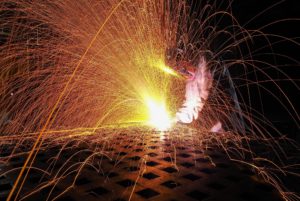 With the eminent growth of the welding industry emerged one of the biggest arguments in the industry: Automated vs. manual welding, which is better? Some might argue that automated is better than manual nowadays, others might argue the opposite and some might say it’s ideal to implement both in your shop.
With the eminent growth of the welding industry emerged one of the biggest arguments in the industry: Automated vs. manual welding, which is better? Some might argue that automated is better than manual nowadays, others might argue the opposite and some might say it’s ideal to implement both in your shop.
There are a number of factors to consider when choosing the welding method to implement in your shop – productivity, budget, the size of your projects and more.
But first, let’s shed light on the difference between the two welding methods.
Automated vs. Manual Welding
Automated welding is divided into two categories, but, in general, the welding operation is done mostly with an automated welding machine. The human presence fits into two roles: either they operate the machine, or they observe the whole welding process while assuring the machines work properly.
This method used to be ideal only for large-scale welding operations, such as mass production of pipes and cars, but as businesses learn the benefits of welding automation, small and medium businesses have turned to welding automation as well.
Meanwhile, in manual welding, the human welder performs the welding operations themselves, with the quality of products relying heavily on their skills. This is ideal for beginners, expert DIYers and small businesses who just need small-scale welding operations.
What differs automated from manual welding in terms of:
Productivity
Automated welding can produce at least twice of what a skilled welder and manual welding can deliver. It also allows you to repeat the welding cycle without impeding the quality of the output. But you can’t fully rely five welders’ worth of work to the automated systems. The machine is still prone to breaking down or malfunction, after all.
Meanwhile, in manual welding, you have to consider the capacity of a human welder – how long he can perform the welding process without straining himself too much, can the welder do his tasks consistently, what if the welder gets sick, etc. Still, skilled welders can deliver the almost-perfect consistent quality and number of outputs in a cost-efficient manner.
Quality
With uniform speed and process, automated welding can produce products with the same quality. It may not be ideal for small touch ups though, which a human welder can simply accomplish with a quick torching on possible areas missed.
Despite this, manual welding could be prone to common quality problems such as the formation of weld spatter, porosity, and shallow penetration, to name a few.
Flexibility
Automated systems are built for any possible adjustments you need to make to fit your welding operations. They also provide easy mobility, thanks to their built-in swivel casters. But in terms of shifting from one welding operation to another, it might take you longer to adjust the automated machine for another welding cycle.
A human welder, on the other hand, can easily transfer from one workstation to another to perform different welding tasks. Manual welding machines might take longer to move, but in terms of completing different welding within a limited time, manual welding is more ideal.
Costs
Automated systems can save you a ton in terms of labor and production costs. You won’t need to hire highly-skilled welders to perform the job – someone who can operate the automated systems would be sufficient. Since there’s less human workforce needed, you can reduce the probability of human errors, reducing the number of production waste as well.
Investment
The investment for an automated welding machine can be costly, especially for startups. Although there are budget-friendly options for turning to welding automation, some might still find the initial investment higher than the investment for a manual welding operation. But you can enjoy the cost-efficient benefits of welding automation in the long run.
For startups, small businesses and those that won’t need to do major welding operations, manual welding might be ideal, budget-wise. You only need to invest in a manual welding machine, some welding materials, and a skilled welder. The total of these investments is smaller, compared to the cost of automated systems.
But in the long run, you might find it to be as costly as welding automation. There’s the labor costs, maintenance repairs, and production waste costs. Not to mention emergency incidents on your shop, like your welder meeting an accident during the welding process.
It all falls to your business’s needs for welding.
At the end of the day, it all comes down to your plans for your business. Do you intend to double production to serve more customers in the future? Do you plan to reduce costs without sacrificing quality and production?
If you want the best of your investment and bring more income for your business, welding automation is worth the shot! With ArcBoss, we can help you automate your welding operations without hurting your budget.
Let’s talk. Contact us now or request a quote!